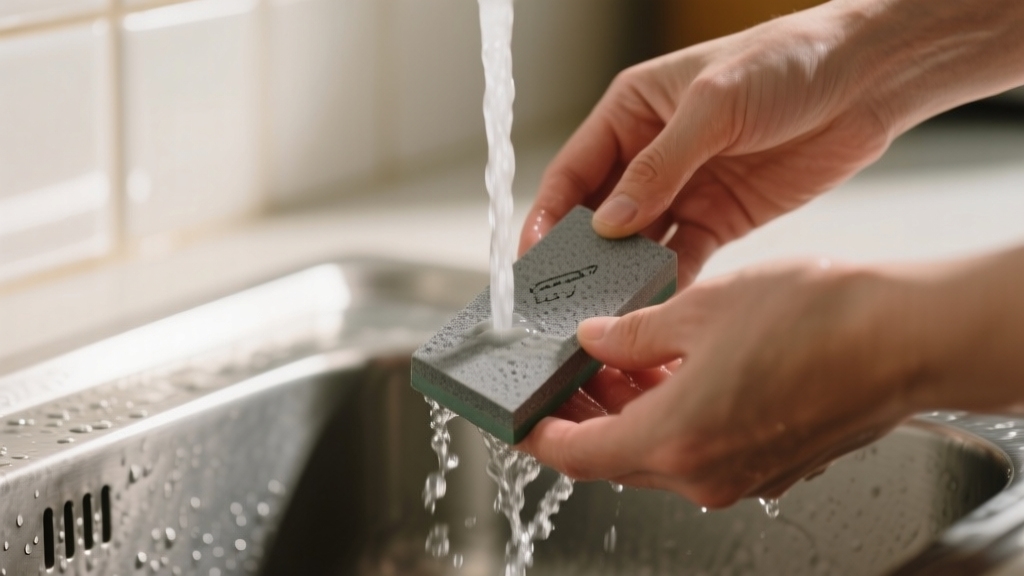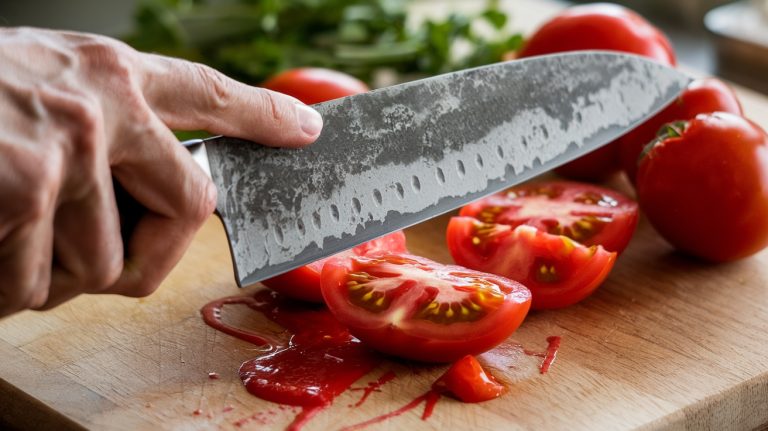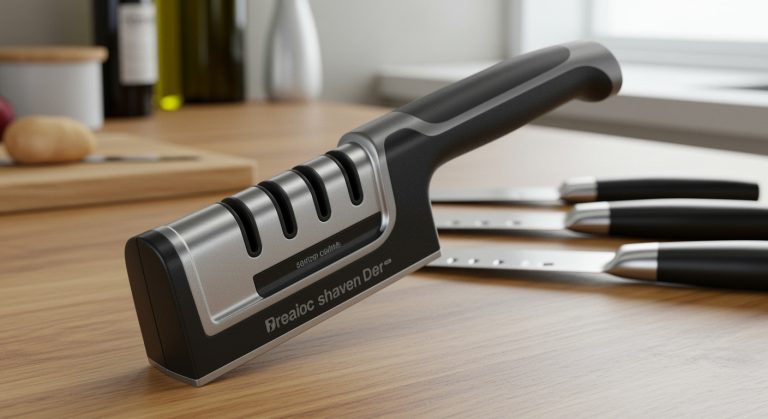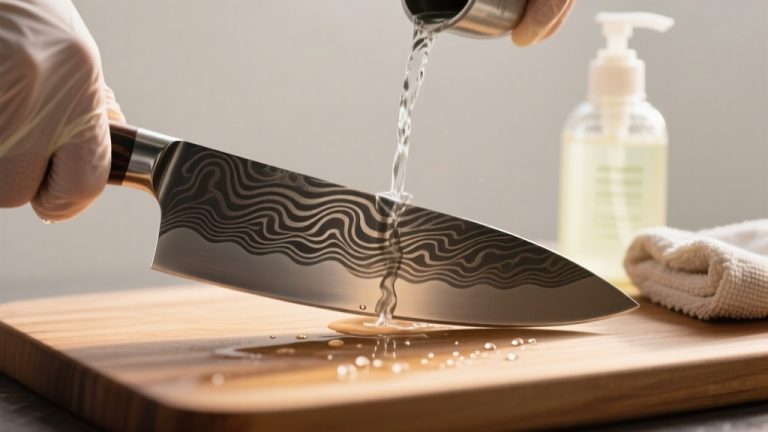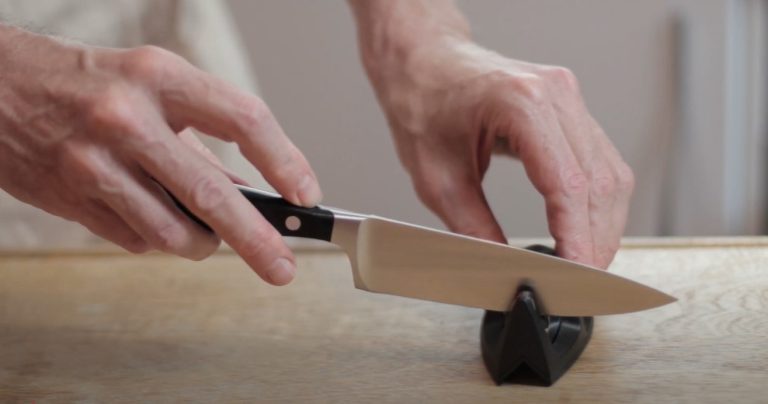How to Clean Diamond Sharpening Stone for Lasting Performance?
To clean your diamond sharpening stone effectively, start by removing swarf with a polymer eraser or stiff brush.
Use mild soapy water or diluted biodegradable cleaners for thorough washing.
Then rinse and dry it immediately to avoid rust. Apply a thin layer of non-toxic oil like Ballistol to protect the surface and prevent moisture damage.
Avoid harsh solvents or abrasive powders to maintain the stone’s integrity. For detailed maintenance tips, you’ll find further expert guidance ahead.
Key Takeaways
- Use a high polymer eraser or nylon brush to remove dry swarf and metal filings gently from the diamond surface.
- Clean with mild dish soap diluted in water, scrubbing softly with a toothbrush, then rinse and dry immediately.
- Apply non-toxic lubricants like Ballistol to loosen embedded grime before scrubbing with fine steel wool or stiff brush.
- Avoid harsh chemicals and abrasive powders to prevent damage to the diamond matrix during cleaning.
- Store stones dry, apply a thin rust-inhibiting oil layer, and keep in a low-humidity environment to prevent rust.
Selecting the Right Cleaning Agents for Diamond Stones
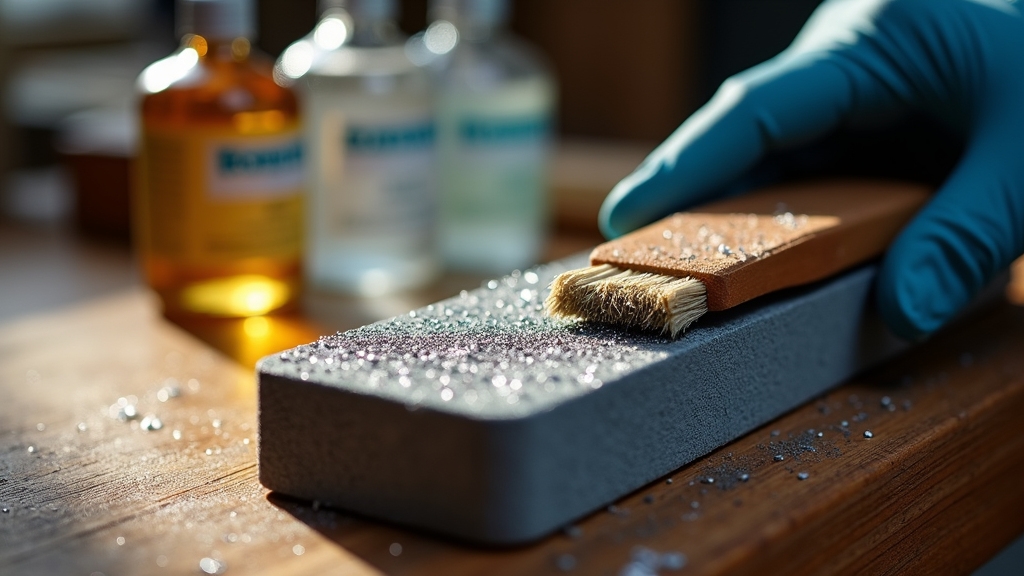
When selecting cleaning agents for diamond sharpening stones, you should prioritize products that effectively remove metal debris and buildup without compromising the stone’s integrity or performance. Eco-friendly or biodegradable cleaners like diluted Simple Green are ideal for routine maintenance, providing effective cleaning while preserving the stone’s bond and user safety.
The DMT Diamond Stone Cleaning Kit is specifically designed for this purpose, offering fast and efficient cleaning of diamond stones. Mild detergents diluted in water, such as dishwashing liquid, safely dislodge swarf under running water.
For thorough cleaning, commercial degreasers like Krud Kutter work well when applied and scrubbed gently with a nylon brush. Non-toxic lubricants, including Ballistol, can lift metal residues and protect against rust. While common household agents like white vinegar or rubbing alcohol may clean effectively, always test on a small area first.
Avoid harsh solvents, undiluted bleach, ammonia, or abrasive powders to prevent damage to the diamond matrix and metal substrate. Proper cleaning also helps maintain the diamond stone’s cutting efficiency and extends its usable life.
Effective Tools for Removing Swarf and Grime
Choosing the right cleaning agents sets the foundation, but effectively removing swarf and grime requires specific tools designed for the task.
You’ll need tools that both lift residues and dislodge embedded particles without damaging the diamond surface. Regular cleaning prevents clogging that slows cutting performance and extends the stone’s lifespan prevent clogging. Consistent maintenance is essential to preserve the sharpness of your sharpening tools.
Polymer erasers, especially specialized rust erasers, provide a dry, chemical-free method by rubbing away swarf.
Mechanical tools like fine steel wool or stiff toothbrushes break up stubborn grime with controlled pressure.
Additionally, light oil sprays such as Ballistol penetrate micropores to loosen metal filings while preventing rust.
- High polymer or rust erasers to lift swarf dryly
- Fine steel wool and stiff toothbrushes for mechanical scrubbing
- Light oils (Ballistol, WD-40) to penetrate and loosen grime
Using these tools ensures thorough cleaning and preserves your diamond stone’s efficiency.
Step-by-Step Cleaning Techniques for Diamond Sharpening Stones
Although diamond sharpening stones require minimal maintenance, following a systematic cleaning routine guarantees ideal performance and longevity.
Begin by erasing surface swarf with a high polymer white eraser, then brush away crumbs. For deep cleaning, scrub with a soft brush and mild soapy water; rinse thoroughly and dry immediately. Additionally, using water only during rinsing helps avoid damage and residue buildup. It is important to ensure the stone is completely dry before storage to prevent moisture interference.
Occasionally, apply a diluted biodegradable cleaner, scrub gently, rinse, and dry. Each step ensures debris removal without damaging the diamond surface.
| Step | Method | Key Action |
|---|---|---|
| 1 | Eraser Cleaning | Rub and brush off residue |
| 2 | Soapy Water Scrub | Gently brush, rinse, dry |
| 3 | Specialized Cleaner | Apply, scrub, rinse, dry |
| 4 | Final Drying | Wipe dry to prevent moisture |
Preventing Rust and Maintaining Stone Longevity
To prevent rust and extend your diamond sharpening stone’s lifespan, you must control storage conditions and perform thorough cleaning after each use.
Store your stone in a dry place using a protective case to shield it from humidity and water exposure. Immediately clean off metal particles with a nylon brush and appropriate cleaner, then dry completely with a cloth. Never rely on air-drying alone.
Apply a thin layer of rust-inhibiting oil, like Ballistol, to create a moisture barrier without clogging the surface.
Store stones on dry mats, away from damp areas or water sources. Use silica gel packs or dehumidifiers to regulate ambient humidity.
Inspect regularly for rust or discoloration and address issues promptly.
Using protective covers similar to those recommended for wooden knife handles can further shield your stone from moisture and scratches.
This disciplined routine ensures your diamond stone remains rust-free and performs ideally over time.
Troubleshooting Common Cleaning Challenges
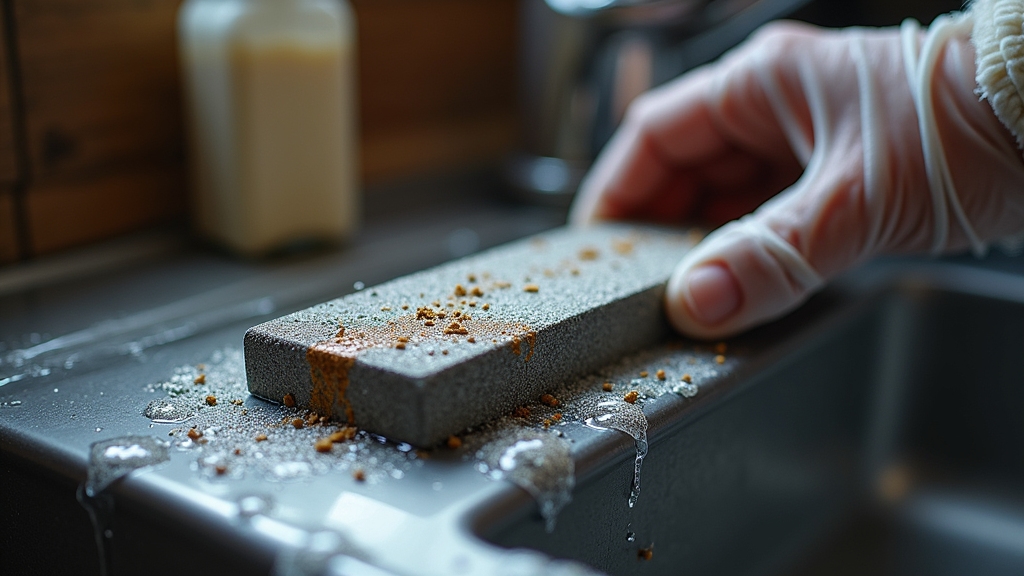
When cleaning your diamond sharpening stone, you’ll often encounter challenges like stubborn grime, embedded metal swarf, and rust stains that resist standard methods.
To tackle embedded swarf, apply Ballistol or WD-40 to loosen metallic fragments. Then gently scrub with a polymer eraser or a stiff toothbrush. Using a polymer eraser designed for diamond stones helps remove particles without damaging the surface. Applying a protective food-safe finish after cleaning can help prevent future contamination and maintain tool longevity.
For ingrained rust, avoid harsh detergents; instead, use automotive window cleaner or scouring powders paired with rubber blocks to dislodge deposits without damaging the diamond surface.
Fine steel wool can help remove persistent grime but must be used cautiously to prevent abrasion.
After cleaning, guarantee thorough drying to prevent rust on the backing.
Regular removal of surface debris with erasers and brushes prevents buildup, maintaining your stone’s cutting efficiency and prolonging its service life.
Frequently Asked Questions
Can I Use Ultrasonic Cleaners for Diamond Sharpening Stones?
Yes, you can use ultrasonic cleaners for diamond sharpening stones.
They effectively remove embedded metal particles and debris, restoring surface quality without abrasive wear.
Ultrasonic cleaning is gentle due to cavitation bubbles, minimizing physical damage.
However, avoid frequent cycles to prevent slight surface alteration from vibration stress.
If your stone has fractures or treatments, exercise caution.
How Often Should I Replace My Diamond Sharpening Stone?
Think of your diamond sharpening stone like a reliable workhorse. It lasts years, but not forever.
You should replace it when you notice surface irregularities, dislodged diamonds, or diminished sharpening performance.
Daily users might need a new stone every few years, while occasional users can go a decade or more.
Keep an eye on wear indicators and manufacturer guidelines to guarantee the best results and avoid wasting effort on a worn-out stone.
Are Diamond Stones Safe for Sharpening Ceramic Knives?
Yes, diamond stones are safe for sharpening ceramic knives when used properly.
You should apply gentle, controlled pressure to avoid chipping the brittle blade.
Avoid twisting or forcing the knife during sharpening and always follow manufacturer guidelines.
Keep in mind, ceramic knives wear down diamond stones faster, so limit use or rotate with steel knives.
Wearing protective gloves enhances safety, and consider professional sharpening for significant damage.
Can Diamond Stones Be Used Wet or Dry?
You can use diamond stones both wet and dry, but wet use is generally better.
Picture water flushing away metal particles, keeping your stone sharp and efficient.
Wet sharpening reduces heat and friction, prolonging diamond grit life while improving control and precision.
Dry use feels faster but risks clogging and requires frequent cleaning.
To maintain peak performance, lubricate with water or a mild solution, ensuring your stone stays open and effective.
How Do I Dispose of Cleaning Fluids Safely?
You should dispose of cleaning fluids by first checking your local hazardous waste regulations.
Never pour them down drains or onto the ground.
Instead, take them to designated hazardous waste collection sites.
Always recycle containers if possible, following local recycling rules.
Store fluids in their original containers until disposal.
Avoid mixing chemicals to prevent dangerous reactions.
Consult the manufacturer’s guidelines for any specific disposal instructions to guarantee environmental safety and compliance.
Keep Your Diamond Sharpening Stone Performing Like New
You might think a diamond sharpening stone cleans itself. After all, diamonds are forever, right?
But neglecting proper cleaning only dulls its edge and shortens its life. By choosing the right agents, using effective tools, and following precise steps, you guarantee peak performance and longevity.
Ironically, the toughest stones demand the most care. So don’t skip maintenance; your diamond stone’s sharpness depends on your diligence, not its hardness.

